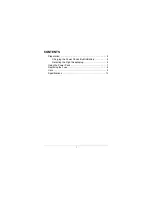
Safety Precautions:
Do not leave the power supply unsupervised while in use
Keep power supply away from heavy vibration, moisture, dust, or excessive heat
Do not move the power supply while in use
Do not operate near fire or water
Use care when transporting to avoid any kind of impact
Do not operate with wet hands
Do not modify or disassemble the power supply
Do not use the power supply to charge a battery, or connect a battery directly to the terminals
Do not connect incompatible chargers to the power supply (do not exceed the amperage load)
The most important factor to consider when using any power supply is to ensure that the unit can supply sufficient wattage as well
as amperage to efficiently operate your charger. There is a simple equation that you can use to determine the wattage necessary to
supply the charger with the power needed to charge a battery. This equation should be performed before you charge any battery
with specifications that differ from the battery you are familiar with.
Step 1:
Volts x Charge Rate in Amps = Watts
First, start with part 1 of the equation to determine the wattage necessary to charge the battery; Voltage x Charge Rate in Amps =
Watts. For an example of this equation, we are going to use a 2S, 5000mAh battery, charging at a 1C amp rate. So, a 2S battery is 7.4
volts, and a 1C charging amp rate for a 5000mAh battery is 5 amps. So you will need to multiply 7.4V x 5Amps, which equals 37
watts.
Step 2:
Watts / Power Supply Output Voltage = Amperage
The Second part of the equation is how you determine the necessary amperage. Start by taking the watt value from part 1 of the
equation (in our example, 37 watts), and divide it by the output voltage provided by the power supply. We will be using 13.8V as our
baseline number, because the ProTek Pro 10 Power Supply produces 13.8V of output voltage. So, because the wattage determined
in part one is 37W, we will divide that by 13.8V. When you perform the 37W / 13.8V equation, you get a amp rate of 2.68 Amps. So,
your power supply would need to be capable of producing 2.68 amps, to charge a 2S, 5000mAh battery, at a 5 Amp Charge Rate
(1C).
So the complete equation is: Power Supply Amperage = (Battery Volts x Charge Rate) / Power Supply Voltage
Now as a second example we will do the equation with a more powerful battery. Let's say you want to find the necessary Supply
Amperage for a 6S, 8000mAh battery at a 2C charging amp rate. 22.2V x 16A = 355 Watts. Then divide 355W by 13.8V; which equals
25.73 Amps, so your power supply would need to be capable of producing 25.73 Amps to charge a 6S, 8000mAh battery at a 16 amp
charge rate.
Equation:
Step 1:
Voltage x Charge Rate in Amps = Watts
Step 2:
Watts / Power Supply Output Voltage = Necessary Power Supply Amperage
Proper Equation:
Power Supply Amperage = (Battery Volts x Charge Rate) / Power Supply Output Voltage
While this calculation may seem complicated at first, it gets easier the more you do it. With today’s high energy Lithium Polymer
Cells and evolving battery technology it is important that you learn this math to ensure peak performance and maximum life span
from your batteries and support gear. Providing "A Higher Level of Performance", ProTek R/C is here to give you the products
necessary to move you to the front of the pack, and the brain power to keep you there. Class is dismissed...Now go have fun!!!
Pro 10 Specifications:
Input Voltage:
110-120V AC
Output Voltage:
13.8V (Regulated)
Wattage:
130W
Output Current:
0-10A (Auto Adjustable)
Output connection:
4mm Banana
Dimensions (LxWxH):
130x92x65mm
Disclaimer and Warranty
All ProTek RC power supplies are covered by manufacturer warranty against defects in materials and workmanship for one (1) year
after original purchase date. Warranty will not cover power supplies that have been modified, disassembled, or otherwise misused
according to the included instructions. ProTek R/C is not responsible for bodily injury and/or property damage that may occur from
the use of, or caused by, this power supply.




















